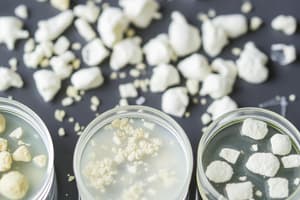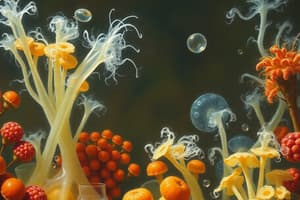Podcast
Questions and Answers
What is the purpose of selective media in microbiology?
What is the purpose of selective media in microbiology?
- To enhance the growth of all bacteria present
- To recover and isolate specific bacteria from a mixed sample (correct)
- To allow the identification of all organisms in a sample
- To suppress the growth of specific bacteria while promoting others
Which of the following media is specifically selective for the isolation of mycobacteria?
Which of the following media is specifically selective for the isolation of mycobacteria?
- Mannitol salt agar
- Blood agar
- CHROMagar
- Lowestein-Jensen medium (correct)
What is the role of malachite green in Lowestein-Jensen medium?
What is the role of malachite green in Lowestein-Jensen medium?
- To promote the growth of mycobacteria
- To enhance lactose fermentation
- To suppress gram-positive bacteria (correct)
- To inhibit the growth of mycobacteria
What characteristic is often used to differentiate bacteria in differential media?
What characteristic is often used to differentiate bacteria in differential media?
What is the minimal inhibitory concentration (MIC) in antibiotic susceptibility testing?
What is the minimal inhibitory concentration (MIC) in antibiotic susceptibility testing?
What is the primary purpose of microbial culture in the laboratory?
What is the primary purpose of microbial culture in the laboratory?
Which type of culture media is specifically designed for the cultivation of fastidious bacteria?
Which type of culture media is specifically designed for the cultivation of fastidious bacteria?
What characteristic is unique to agar as a solidifying agent in culture media?
What characteristic is unique to agar as a solidifying agent in culture media?
Which category of culture media is classified based on its ability to support the growth of certain bacteria while inhibiting others?
Which category of culture media is classified based on its ability to support the growth of certain bacteria while inhibiting others?
What type of culture media contains only known and well-defined chemical constituents?
What type of culture media contains only known and well-defined chemical constituents?
What information can be obtained from in vitro cultures of pathogenic bacteria?
What information can be obtained from in vitro cultures of pathogenic bacteria?
What distinguishes complex culture media from synthetic culture media?
What distinguishes complex culture media from synthetic culture media?
Which culture media type is described as supporting the growth of microorganisms for further study?
Which culture media type is described as supporting the growth of microorganisms for further study?
Which characteristic of agar makes it suitable for use in microbiological applications?
Which characteristic of agar makes it suitable for use in microbiological applications?
At what temperature does agar liquefy?
At what temperature does agar liquefy?
What is the primary purpose of a chemostat in microbiological research?
What is the primary purpose of a chemostat in microbiological research?
What does the zone of inhibition indicate in a disk diffusion test?
What does the zone of inhibition indicate in a disk diffusion test?
Which agar is recommended for antibiotic susceptibility testing?
Which agar is recommended for antibiotic susceptibility testing?
What process is catalyzed by hemolysins observed in blood agar?
What process is catalyzed by hemolysins observed in blood agar?
In a disk diffusion test, how much antimicrobial sample is typically loaded onto each disc?
In a disk diffusion test, how much antimicrobial sample is typically loaded onto each disc?
What is a primary function of enriched nonselective media like blood agar?
What is a primary function of enriched nonselective media like blood agar?
Flashcards
Microbial Culture
Microbial Culture
A technique used to multiply microbial organisms like bacteria and fungi by allowing them to reproduce in a controlled lab environment.
Why is Microbial Culture Important?
Why is Microbial Culture Important?
The study of microbial cultures helps in isolating and cultivating bacteria, understanding their morphology, and determining their susceptibility to antibiotics.
Culture Media
Culture Media
Materials that provide nutrients and conditions necessary for microorganisms to grow and multiply in the lab.
Consistency of Culture Media
Consistency of Culture Media
Signup and view all the flashcards
Complex Culture Media
Complex Culture Media
Signup and view all the flashcards
Synthetic Culture Media
Synthetic Culture Media
Signup and view all the flashcards
Agar
Agar
Signup and view all the flashcards
Turbidity
Turbidity
Signup and view all the flashcards
Zone of inhibition
Zone of inhibition
Signup and view all the flashcards
Selective media
Selective media
Signup and view all the flashcards
Differential media
Differential media
Signup and view all the flashcards
Lowestein-Jensen medium
Lowestein-Jensen medium
Signup and view all the flashcards
CHROMagar
CHROMagar
Signup and view all the flashcards
Agar: What is it?
Agar: What is it?
Signup and view all the flashcards
What is a bacterial colony?
What is a bacterial colony?
Signup and view all the flashcards
What is a bacterial growth curve?
What is a bacterial growth curve?
Signup and view all the flashcards
What is a chemostat?
What is a chemostat?
Signup and view all the flashcards
What is an antibiotic susceptibility test?
What is an antibiotic susceptibility test?
Signup and view all the flashcards
What is Mueller-Hinton agar?
What is Mueller-Hinton agar?
Signup and view all the flashcards
What is the Kirby-Bauer test?
What is the Kirby-Bauer test?
Signup and view all the flashcards
What is a hemolysis test?
What is a hemolysis test?
Signup and view all the flashcards
Study Notes
Bacterial Cultures
- Microbial culture is a method to grow microorganisms (bacteria and fungi) in a lab.
- In vitro cultures of bacteria allow for:
- Isolation and cultivation of pathogenic bacteria
- Morphology analysis of colonies and phenotypic characteristics for identification
- Antibacterial susceptibility testing for choosing suitable antimicrobial agents
- Microbial culture identification is crucial to determine the causative agent of a disease.
Culture Media
- Culture media are nutrient media, artificial growth mediums for microbial propagation.
- Types of culture media are categorized by consistency (solid, semi-solid, liquid/broth).
- Categorized by nutritional components:
- Complex media (undefined): contain unknown nutrients, used for fastidious bacteria (requiring extra nutrients like blood, serum, yeast or meat extract).
- Synthetic media (chemically defined): contain known and well-defined chemical constituents.
- Categorized by function/property:
- Selective media: promotes growth of certain bacteria while inhibiting others.
- Differential media: allows differentiation of bacteria based on their metabolic activities (e.g. lactose fermentation).
- Indicator media: show the presence of a specific substance in the medium.
- Enriched media: support the growth of specific species that need extra nutrients.
- Composite media: combination of properties.
- Storage media: maintain viability of cultures.
- Transport media: for safely carrying specimens for analysis.
Liquid Culture Media (Nutrient Broth)
- Nutrient Broth: liquid medium for nonfastidious microorganisms.
- Can be supplemented with blood, serum, sugars, etc. for special purposes.
- Typical formula (g/L): Beef Extract (1.0), Peptone (5.0), Yeast Extract (2.0), Sodium Chloride (5.0).
- Final pH 6.8 ± 0.2 at 25°C.
- Principle: components provide essential nutrients (amino acids, nitrogen, carbon, vitamins, minerals) and maintain osmotic balance for growth.
Solid Culture Media (Agar)
- Agar: unique solidifying agent from red-purple marine algae.
- Properties:
- Stable during sterilization
- Physiologically stable upon usage and storage
- Nontoxic to bacterial growth.
- Liquifies at 100°C, solidifies at 50°C
- Crucial for growing bacteria in agar plates for specific tests and observation.
Solid Medium for Bacteria (Nutrient Agar)
- Nutrient Agar ISO 6579: a non-selective medium for cultivating various microorganisms.
- Typical formula (g/L): Meat Extract (3.0), Peptone (5.0), Agar (15.0).
- Final pH 7.0 ± 0.2 at 25°C.
- Principle: Components supply essential nutrients (amino acids, nitrogen, carbon, minerals, vitamins) for microbial growth. Agar is the solidifying agent.
Microbial Growth Curve
- Stages: Lag phase, Log phase (exponential growth), Stationary phase, and Decline phase.
Continuous Culture Device (Chemostat)
- Chemostat: maintains a constant Log phase of bacterial growth.
- Flow control of fresh medium and outflow of spent medium.
Bacterial Growth vs Oxygen Concentration
- Obligate aerobes: require oxygen
- Obligate anaerobes: cannot tolerate oxygen
- Facultative anaerobes: can grow with or without oxygen
- Aerotolerant anaerobes: tolerate oxygen but do not use it for growth.
Bacterial Growth in Solid Media
- Observed as colony formation.
- Isolated colonies grow from single bacterial cells.
- Colony characteristics (e.g., shape, elevation, margin) aid in bacterial identification.
Bacterial Colony Morphology
- Categorized by form, elevation, and margin shape
Enriched Nonselective Media
-
Blood agar: contains 5% sheep/horse blood to test hemolysis.
-
Chocolate agar: modified blood agar via heating blood to a chocolate-brown colour.
-
Mueller-Hinton agar: recommended for antibiotic susceptibility testing.
Disk Diffusion Test (Kirby-Bauer Test)
- Antimicrobial susceptibility test performed on Mueller-Hinton agar.
- Antibiotic discs are placed on the agar plate containing the microorganisms.
- Inhibition zones are measured to determine the effectiveness of different antibiotics.
Antibiotic Susceptibility Testing in Liquid Medium (MIC)
- Serial 2-fold dilutions of antibiotics in Mueller-Hinton broth.
- Inoculate with a known amount of microorganisms.
- Determine the lowest antibiotic concentration that inhibits bacterial growth (MIC).
Selective Media and Differential Media
- Selective media: specifically designed to recover particular bacteria from a mixture.
- Examples: Mannitol salt agar, Lowenstein-Jensen agar, CHROMagar.
- Selective media can also be differential to visually identify and differentiate.
Studying That Suits You
Use AI to generate personalized quizzes and flashcards to suit your learning preferences.




